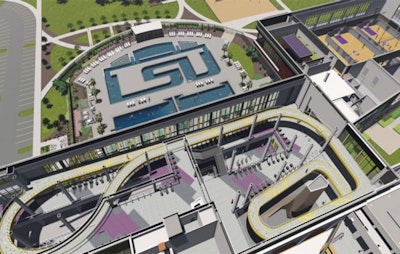
“LSU Faces Dramatic Budget Cuts While It Builds An Expensive Lounging Pool” This was the headline of an article that appeared in The Huffington Post this past May criticizing Louisiana State University’s spending of $84.75 million on an overhaul of its recreation facilities despite a threatened $55.5 million funding cut from the state.
Last week New Jersey governor Chris Christie admonished what he considers wasteful spending in the higher education system, denouncing “extras” such as lazy rivers and climbing walls.
"Some colleges are drunk on cash and embarking on crazy spending binges,” he said.
If you work in college recreation, the incidents made you cringe.
The cost of higher education is going to get a lot of attention leading up to the 2016 election, and unfortunately, that’s going to come with a lot of misguided scrutiny of campus recreation programs.
What both incidents overlook — as anyone working in college recreation will immediately recognize — is that a university’s education budget and recreation budget are two entirely different things. Campus recreation centers are not built at the expense of science labs or classrooms. For most universities, such projects are funded (and maintained) from students fees.
"The funds for the project come directly from the student fee and can only be used for the project," LSU spokesman Ernie Ballard told The Huffington Post. "Similar to donations to the university or funds from the state for capital projects, these types of funds can't be shifted to fill in budget holes or be used in another way. They can only be used for what they were originally designated for."
The impact of such facilities on the price of a college education is actually minimal, according to David Feldman, economics professor at College of William & Mary.
“Lazy rivers are only a tiny piece of the costs,” he told Inside Higher Ed. “These lazy rivers are not the reason why student debt is soaring seemingly out of control. The big problem that higher education faces today, at the public side, is cuts in state spending.”
Some argue that cuts in spending are actually driving the construction of bigger and better recreation amenities, as universities look draw in more out of state students. According to research from the University of Michigan, “wealthier students [are] much more willing to pay for consumption amenities.”
Despite its negative headline, The Huffington Post article went on to admit as much, quoting a 2013 article in which former Miami University president James Garland explains, “We took advantage of low interest rates for municipal bonds and invested in rehabilitating our residence halls and eating facilities and putting in more recreation -- workout rooms and lounges, and the kinds of accouterments that really dressed up a campus and made it a much more comfortable and familiar place for upper-middle class students. So those students started applying to us in droves. Application numbers went up, we became more selective, and the SAT scores of the entering class became higher."
So, in the face of a $55.5 million budget cut (avoided, thankfully) LSU would need to rely more heavily on the appeal of its non-academic offerings to bring in more students and more revenue. As Jane Wellman, a finance expert with College Futures Foundation, told Inside Higher Ed, the issue is not of how colleges spend money, but the priorities of schools.
“The sense is that college costs are going up too rapidly, and institutions aren’t doing enough to control them,” she says. “The critique underneath that is the critique of the decision-making culture in higher education.”
Rather than ask why LSU would spend $85 million on a recreation center, maybe politicians should be asking why the state of Louisiana was mulling a $55 million cut to education.
We won’t get into the other complexities of campus recreation facilities, such as the positive economic impact of construction (According to NIRSA, $1.7B was spent on 157 recreation construction projects in 2012), the employment opportunities afforded to students, the educational programming opportunities, the importance of recreation to students' quality of life (and GPA), the role in building a schools’ reputation, or any number of issues.
Unfortunately, neither will the politicians pinning the climbing costs of higher education on climbing walls.

































